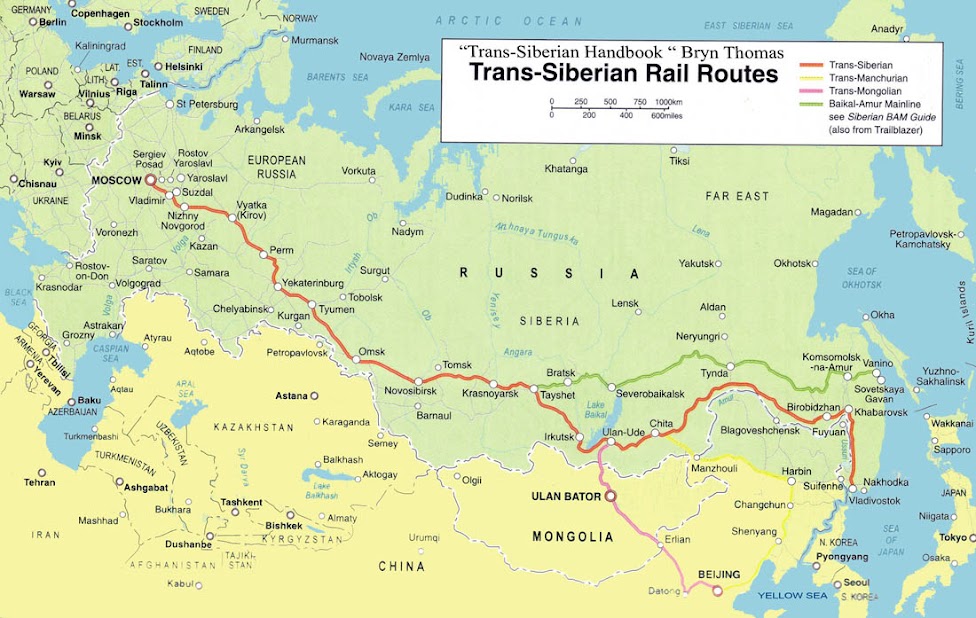Choo, choo, all aboard!
On our quest to get a sense of the sheer size of the world’s largest country and its varied landscapes, we continue our sojourn on the legendary Trans-Siberian Railway, an epic train ride across 8 time zones and 9,289 km all the way from Moscow to Vladivostok that takes 6 nights and 7 days if you don’t break up the journey (it takes more than nine hours to fly!).

Having survived the Arctic wilderness, we board the iconic train № 100 in the south Siberian town of Tyumen and will only cover a distance of 3049 km and 3 time zones in exactly 48 hours 24 minutes to reach Irkutsk.

Those of you who are short on time may want to jump to the respective sections of your interest by clicking the bullet-pointed links below, although I’d highly recommend you stick with us to feel the Siberian Magic.
Your Ultimate Guide to Trans-Siberian Railway Journey
- What is the Trans-Siberian Railway Network?
- Life Aboard the Trans-Siberian Railway
- Siberian Magic: Exploring Irkutsk Oblast and the Buryatia Republic (East of Lake Baikal)
- Siberian Magic: Exploring the Frozen Lake Baikal and Olkhon Island on a Russian Military Van
- Planning Tips to Experience the Trans-Siberian Railway Journey Yourself
- GOODBYE RUSSIA (Season 1, Ice Worlds Finale)

What is the Trans-Siberian Railway Network?
To Russian people, the Trans-Siberian Railway is merely a commuter train. Russians use it to go home, visit family, and reach army bases at remote stations. For many foreign travelers, though, it’s more than just getting from A to B. It’s the quintessence of romantic train journeys, the chance to travel across Siberia that occupies roughly 10% of the earth’s landmass stretching from the Ural Mountains in eastern Europe to the Pacific Ocean in East Asia.

The mainline and the longest route of Trans-Siberian Railway starts from Moscow and ends in Vladivostok, in the Russian Far East.
The Trans-Siberian Railway, which was completed over 25 years between 1891 and 1916, has connected Moscow with Vladivostok since 1916 stopping at hundreds of large and small cities of the European and Asian parts of Russia. A second route, the lesser-known but much more scenic Baikal-Amur-Mainline, runs through Siberia along the north of Lake Baikal and connects to the Trans-Siberian Railway Network at the station of Tayshet.
Furthermore, there are two routes to China. Most tourists opt for either the Trans-Mongolian line from Moscow to Beijing via Mongolia or the Trans-Manchurian line (see the yellow route above). As these lines run only partially along the Trans-Siberian route, they’re beyond the topic of this blogpost.
Life Aboard the Trans-Siberian Railway
Note: If you haven’t read my blog post about our journey aboard the Polar Arrow, I’d strongly recommend that you do so now or at least watch the video linked in the post: https://earthmaho.com/2020/06/train-journey-trans-polar-siberia-russia.html because that train journey highly influenced my experience and opinion about the Trans-Siberian.
Being experienced train riders, if I may claim, on this leg of our journey from Tyumen to Irkutsk we’re traveling again in a Platskartny car: the third class with 54 bunk beds with no privacy.

Just like the Polar-Arrow, there is a samovar (water boiler) in each wagon, and again we are the only foreigners among local families, students, workers, and soldiers. Soon the same routine sets in: Passengers flip-flop back and forth to the samovar to make tea or rehydrate instant noodles, eat, chat, daydream, sleep, and repeat.
So far so good. But as a difference this time, we couldn’t secure the lower berths and had to settle for the upper berths, where it’s impossible to sit upright, not even for a petite lady like me. Moreover, unlike the Trans-Polar, there would be no break from the hustle and bustle of the stations as we further penetrate deeper in Siberia. People would keep embarking and disembarking at each and every stop. As a result of the constant hubbub, the conductress is also quite unfriendly. And to add insult to injury, we notice that traveling along Southern Siberia in late March is not the best idea, as the landscape is bleak.
As you can see in the video at this link https://youtu.be/Mb45tVeu8n8, there wasn’t that much snow in the southern part of Siberia. The outside temperature in Tyumen was around a comfortable -2 °C where wearing only one layer of a jacket was sufficient. On the train, a high of 30 °C made us sweat like in a sauna even with a t-shirt.
Due to all the negative points mentioned above, I’d never ever travel along this busy route on the Trans-Siberian Railway again. The journey was far from being authentic and romantic. The train ride to the Arctic Circle on the other hand was exactly the way I’d imagined that I’d do it in a heartbeat again.
Siberian Magic: Exploring Irkutsk Oblast and the Buryatia Republic (East of Lake Baikal)
Accustomed to the enormous Russian dimensions, only two days of a raucous carriage ride later, we disembark in the peace and serenity of Irkutsk at night and quickly grab a taxi via Yandex App to our hostel. The next morning we would go on a little road trip in the Tunka Valley to explore the Central-East Siberia along the Mongolian border and to pamper ourselves in the mineral springs of Arshan village.
On our way to Arshan, we first stop by the Kultuk village for the views of the southern point of Lake Baikal, where we set foot for the first time on the deep-frozen lake.


We then continue driving through the Tunka Valley and make stops as often as we fancy. Tunka valley is considered one of the natural pearls of the Buryatia Republic. With its warm climate, fertile land, and excellent pastures, the valley has been inhabited for a very long time. With a current population of just 26,000, the Tunka Valley retains the rural Siberian feeling.





Upon arrival in Arshan, we check in to a rustic guesthouse. In the afternoon we tour the area, taste the mineral springs and take a short hike along Kyngyrga river to admire the wild Siberian mountainous nature.







The next day after breakfast we drive to the spa town of Zhemchug, which means Pearl and is famous for its hot springs and mud baths. We visit one of the spas that are composed of shacks, a visit that shifts our perception of spas for sure. Nevertheless, wooden pools dug into the ground are no obstacle to enjoy the 38°C methane-rich and 55°C carbon dioxide-rich waters that flow naturally from deep-drilled wells.

Being pampered, we follow the same way back to Irkutsk. The quiet, rustical Arshan village among the mountains turns out to be the much-needed balm for the soul. But much better is the drive in the Tunka National Park along the seemingly endless Sayan Mountains on one hand side and the Mongolian border on the other. Here is a taster: https://www.youtube.com/shorts/hrCzvFrO15Y?feature=share
The Tunka Valley lies in the western part of the Republic of Buryatia that mainly covers the eastern shore of Lake Baikal and gives a feeling of the “Wild West” in the Central-Eastern Siberia (yep, I am confused too :)) Russia never ceases to amaze me. It’s magnificent, amazing, and overwhelming in every sense of the word, and here are some pictures worth a thousand words.






Back in Irkutsk, we stroll through the city at spring-like temperatures of +14 °C. Irkutsk, a city that Chekhov described as “elegant and European“, has century-old pretty wooden mansions, vibrant churches, and good restaurants.


As beautiful as Irkutsk might be, the vast, untouched wilderness of Lake Baikal is waiting to be explored. So, the next morning we are set to join a 3 days/2 nights tour of Lake Baikal and Olkhon Island on a UAZ, Russian Military van.
Siberian Magic: Exploring the Frozen Lake Baikal and Olkhon Island on a Russian Military Van
Lake Baikal, covering an area bigger than Belgium, is the world’s largest freshwater lake by volume, holding about 20% of the world’s total surface-water reserve. In winter, the lake is frozen so solid that serves as a temporary road connecting the settlements along its shores. With ice thickness reaching 1-1.5 meters on average, it’s strong enough to hold vehicles up to 15 tons until mid-March. Imagine how powerful the Russian winter must be in order to completely freeze the deepest and oldest freshwater lake in the world.
A minibus picks us from our hostel in Irkutsk and we drive along the Primorsky Mountains on Baikal’s western shore to the Olkhon Island ferry. At the end of March, the ice thickness is still safe enough to walk but driving on the lake is no longer possible, hence we make the 8 km crossing on ice by the Hivus Air-Cushion boat (https://youtu.be/1wRUR6Zt5uo) to the Olkhon Island, the third-largest lake-bound island in the world, located 250 km north of Irkutsk.
As soon as we arrive on the island, we hop onto the UAZ military vans and check in to our accommodation in Khuzir, the island’s main town, where 1200 of the island’s 1500 inhabitants live.

Olkhon is populated primarily by the Buryati whose Buddhist practices coexist with their shamanism. After settling in our hotel, we walk through the icy streets of Khuzhir to the Cape of Burkhan to see the famous Shaman Rock Shamanka, the symbol of Baikal.

The next two days, right after breakfast we jump onto our UAZ, Russian military jeeps to visit the popular vantage points on the Olkhon Island and behold the classic Lake Baikal vistas, including the 200m high cliffs of Khoboy Cape at the northern tip of the island. We make several stops to walk on the frozen lake to see the eerie ice formations, coastal ice caves, frozen stretches of beach along the shore. Once again, I’ll let the pictures speak for themselves to help you take in the immense natural beauty of Lake Baikal.


























Planning Tips to Experience the Trans-Siberian Railway Journey Yourself
Embarking on a once-in-a-lifetime train journey across Siberia requires careful planning and a sense of adventure. First things first:
- The Trans-Siberian Railway is not a hop-on/hop-off affair. If you decide to break up the journey from Moscow to Vladivostok (or Beijing), you’ll need to buy separate tickets for each leg of the trip.
- Depending on your nationality, make sure to apply for visas in advance. You can buy your Russian Visa Invitation here (Update 2024: Russia introduced e-visa, which does not require any invitation).
- The trains run along the Trans-Siberian, Trans-Manchurian and the Trans-Mongolian railways all year round. Decide on the season to visit and plan accordingly. You might be tempted to summer, but in our opinion, Siberia can truly be experienced in winter. Russia is famous for its freezing cold winters, and from Russian Banya to hearty food, everything is designed to maximize enjoyment in sub-zero temperatures.
- You can book your Trans-Siberian train tickets online directly on the Russian Railways website. It’s pretty straightforward except for a few minor obstacles, for instance, you may not be able to find the stations you’re looking for due to different spelling. If Tyumen does not show up, try Tiumen.
- Be aware that some trains take longer, some may be indirect. I found https://www.tutu.travel website pretty useful for checking schedules and stations, however, you would pay more if you book via their website.


- The Trans-Siberian train schedule runs on Moscow time. As you speed through the time zones, make sure that your watch is not automatically set to local time.
- There is no shower on board, no WiFi, and usually a single plug to share for each wagon.
- Make sure to pack light, comfortable clothing, and slippers to feel yourself home. And pack some food if you don’t want to spend 10 $ for a mediocre meal in the restaurant car.
- Tourism in Siberia is rather uncommon, thus there’s very little information in English. While the locals will welcome you with a warm smile, make sure to have a translator app and a local SIM card. It’s easy to buy a Russian prepaid SIM card with your passport. The rate for a month of an unlimited data plan was as of March 2018 750 Rubles/11 euros. However, it is only valid for the Oblast (region) bought. What? Roaming within the one and the same country?! Yeah, Russia is so big that you constantly roam while traveling. We had to pay 450 Rubles more in order to get coverage in the whole of Russia. And of course, don’t expect to catch any signal along the way, it would only work close to the settlements.
- We only traveled in the third class and had no safety or hygiene concerns. The bathrooms and the cars were regularly cleaned by the conductress. And the thing about drinking vodka seems to be a myth, which is possibly spread by the tourists traveling in the second and first-class. During our train journeys in the third class, we didn’t meet a single person consuming alcohol. But instead, tea seems to be the national drink. You can find tea even in pubs, freshly made with any flavor imaginable.

- To get a taxi in towns, apps like Uber, Getty are all available and very useful because of the language barrier. Russians use the Yandex Taxi app though, which we also used religiously as it constantly had cheaper rates than others. So make sure to download the Yandex app as well.
Last but not least, bear in mind that the whole point of embarking on such a journey is to get a sense of the vast distances, and to gain the ability to make yourself home on the train. So, in our opinion, a journey of 48-56 hours would be sufficient to serve its purpose. Or if you are a hard-core traveler, covering the Moscow-Irkutsk leg without stops would be more than enough (~75 hrs). Other than that, you won’t get a medallion or so if you travel along the entire route.
I’d also strongly recommend you make as little stops as possible to save time for in-depth exploration of a given region. For example, Irkutsk Oblast and Lake Baikal deserve a week at least. Also, keep in mind, sometimes flying might be cheaper than taking the train. And there are way cheaper bus services as well, even to Mongolia. It all comes down to your expectations for such a trip.

GOODBYE RUSSIA (Season 1, Ice Worlds Finale)
I tend to romanticize things while planning in front of the screen. It’s something I am aware of and I can deal with. But I didn’t know I had created an obsession all by myself to cross the largest country in the world coast to coast, all the way from Saint Petersburg in Europe to Sakhalin in the Pacific. A romantic idea in my mind that didn’t feel right any longer.
Having arrived slightly too late for the winter season on Lake Baikal, my initial idea of continuing the train journey from the north of the lake, along the lesser-known but much more scenic Baikal-Amur-Mainline route didn’t appear to make much sense anymore. Due to the melting snow, the activities I was interested in doing would no longer be possible, just like we were too late for observing the black ice phenomena on Lake Baikal.
The reward to effort ratio continued shrinking with each email exchange with the local guides from the region. I started feeling stressed to accomplish my duty without a sign of joy, up until an article about an interview with Anthony Bourdain caught my attention, reminding me that
“Plans should be ephemeral, so be prepared to move away from them.”
He was right. After covering a total of over 10500 km by trains (more than 100 hours), planes, and busses, it was time to leave Russia for the moment.
I am sure we will visit Russia several times in the future, in winter as well as in summer to explore more of Russia’s amazingly diverse and spectacular nature and people. After all, Russia is simply too big, too diverse, and too amazing to conquer in a single trip.
See you on another adventure!
This post concludes our month-long adventures in Russia. If you missed the previous parts of our journey, make sure to read them here:
- St. Petersburg vs Moscow Duel in Pictures
- Journey to the Arctic Siberia aboard the Trans-Polar Train
- Homestay at the End of the Earth with the nomadic Nenets




